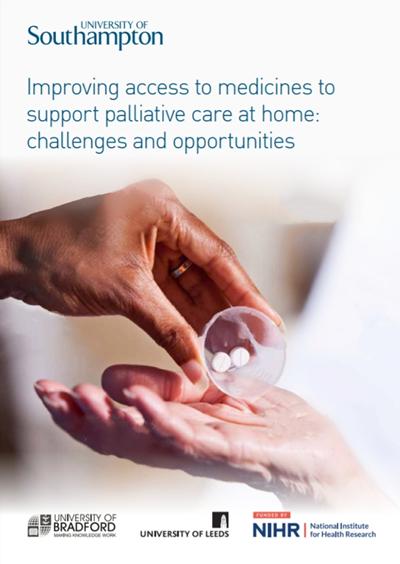
Policy Briefs
Click to read UoS Students and Academics reflecting on their experience of engaging with PPS and policymakers.

Background:
Patient and carer access to medicines during the last 12 months of life (end-of-life) is critical for control of symptoms, including pain and distress, and for reducing urgent, unplanned use of healthcare services. However, data from our previous studies suggested that prescription, dispensing, supply and associated information given about medicines are experienced by patients as often difficult, demanding, lacking co-ordination, and involves a multiplicity of professionals. Although evidence is suggestive of patient and carer access problems with traditional service delivery systems, including General Practitioner care, little is known about this. Additionally, there are indications that critical sectors of the end-of-life workforce – palliative care nurse specialists and community pharmacists - are currently under-utilised. Furthermore, whilst there are some promising innovations in end-of-life care models, the impact of these on patient access to medicines, as well as their cost-effectiveness comparative to more traditional delivery models, remains largely un-evaluated. Our recent research also suggests that the supply chain ‘upstream’ may be a contributing factor to the complexity and problems with access experienced by patients.
Aim:
We aimed to provide an evaluation of patient and carer access to medicines at end-of-life within the context of models of service delivery.
Design and data sources:
Multiphase mixed methods design. 1: Systematic literature review. 2: Online questionnaire survey of healthcare professionals delivering end-of-life care. 3: Evaluative, mixed method case studies of service delivery models, including cost and cost-effectiveness analysis. 4: Interviews with community pharmacists and pharmaceutical wholesalers and distributors. 5: An expert consensus-building workshop.
Findings:
A systematic review identified a lack of evidence on service delivery models and patient experiences of accessing medicines at end-of-life. 1327 healthcare professionals completed an online survey. Findings showed General Practitioners remain a predominant route for patients to access prescriptions, but nurses and primary care-based pharmacists are also actively contributing. However, only 42% (160) of Clinical Nurse Specialists and 27% (27) of Community Nurses were trained as prescribers. The majority (58% 142) of prescribing nurses and pharmacists did not have access to an electronic prescribing system. Healthcare professionals’ satisfaction with access to shared patient records to facilitate medicines access was low: 39% (507) were either Not At All or only Slightly satisfied. Respondents perceived there would be a significant improvement in pain control if access to medicines was greater. Case studies highlighted differences in speed and ease of access to medicines between service delivery models. Healthcare professionals’ co-ordination facilitated the access process. The work of co-ordination was frequently burdensome, often due to hard-to-access General Practitioner services and unreliable community pharmacy medicines’ stock. Prescription cost differentials between services were modest but were substantial when accounting for the eligible population over the medium term. The supply chain generally ensured stocks of palliative medicines, but this was underpinned by onerous work by community pharmacists navigating multiple complex systems and wholesaler interfaces.
Conclusion:
Accessing medicines required considerable co-ordination work. Delays in access were linked to service delivery models that were over-reliant on GP prescribing, community pharmacy medicines’ unreliable stock, and Clinical Nurse Specialists’ lack of access to electronic prescribing. Key issues were relationships and team integration, diversifying the prescriber workforce, access to shared records and improved community pharmacy stock.
Implications:
Greater consideration should be given by service delivery commissioners and managers to implementing named end-of-life care co-ordinators.
To expand and diversify the prescriber workforce, funding and support will be required to train more community nurse specialists and generalists to prescribe medicines independently to palliative care patients.
Findings suggest all community-based healthcare professionals need access to electronic prescribing systems.
Findings also point to the need for greater harmonisation of information technology systems so that all healthcare professionals have access to shared electronic patient records across service organisations’ interfaces.
Commissioning telephone support services might offer single-point-of-contact, cost-effective models of provision that co-ordinate medicines access systems, and act as information-giving hubs for end-of-life medicines and services.
Greater integration of community pharmacists within the wider community healthcare team to facilitate information-sharing about patients and their medicines is needed.
Commissioning of community pharmacy services for palliative care would benefit from a shift to a more standardised core list of medicines, with greater and more even distribution of pharmacies or other community hubs holding stock, accessible out-of-hours.
Pharmaceutical wholesalers / distributors need to engage with community pharmacists both individually and collectively for two-way communication about practices that reduce pharmacist work and best support palliative care medicines supply.
Given the potential substantial cost differences between services, additional health economics research is required to generate further evidence to inform service provision decisions.
Funding and disclaimer: This study is funded by the National Institute for Health Research (NIHR) [Health Services & Delivery Research programme] (project number 16/52/23). The views expressed are those of the author(s) and not necessarily those of the NIHR or the Department of Health and Social Care.
NIHR Journals Library website study page https://www.journalslibrary.nihr.ac.uk/programmes/hsdr/165223/#/
References:
Ogi M Campling N Birtwistle J Richardson A Bennett MI Santer M Latter S What are patients’ and health professionals’ experiences of access to palliative care medicines in different models of community care provision? Systematic review and narrative synthesis. 2021 BMJ Supportive and Palliative Care (in press)
Latter S, Campling N, Birtwistle J, et al. Supporting patient access to medicines in community palliative care: on-line survey of health professionals’ practice, perceived effectiveness and influencing factors. BMC Palliative Care 2020;19(148) https://doi.org/10.1186/s12904-020-00649-3 (accessed: 10 Oct 2020)

Click to read UoS Students and Academics reflecting on their experience of engaging with PPS and policymakers.

Click here to listen to our Policy Podcast series. In each episode we speak to the UoS researchers and experts, about their experiences in the domestic and foreign policies.

Guidance on the many channels available to researchers to engage with policymakers.

Guidance on things to consider in the science to policy process and useful tips in planning and costing your impact activities.